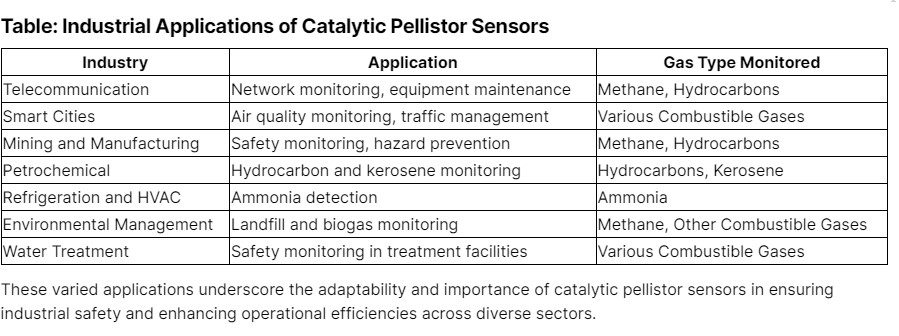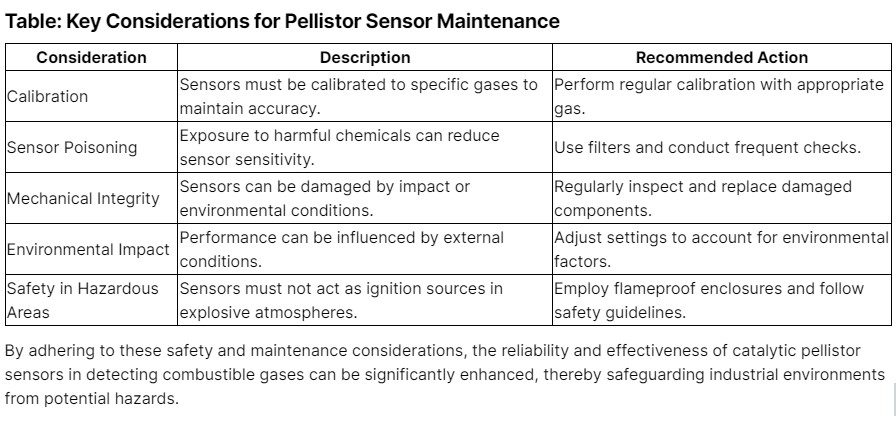Pellistor bead chemical sensors, also known as catalytic pellistor sensors play a role, in detecting flammable gases such as methane. These sensors use a bead to heat a platinum coil that is contained within the bead representing an advancement in safety technology. Catalytic pellistors, which combine the words ‘pellet’ and ‘resistor’ are solid state devices that detect gases by monitoring changes in resistance when these gases are present. This technology serves as a warning system for industrial safety by detecting hazardous gas levels before they become a danger.
The advancement of Catalytic pellistor sensor technology has expanded their use across industries. This article will delve into the journey of these sensors from their inception to how they operate, the types of pellistor sensors on the market their applications in industry specific scenarios and considerations, for ensuring safety and maintenance. By gaining insight into how these sensors have developed and function industries can enhance their ability to protect against risks associated with gases.
History and Development
- Origins in Mining Safety: Catalytic pellistor sensors were first introduced in the 1960s with a focus, on replacing flame safety lamps commonly utilized in mining activities. The main objective of these sensors was to offer an more dependable way to detect flammable gases in underground settings. Notably English scientist Alan Baker played a role in transitioning, from canary based detection techniques to more advanced scientific methods.
- Transition from Flame Safety Lamps: Before the advent of catalytic sensors, combustible gases in mines were detected using flame safety lamps. These lamps were not only inaccurate but also lacked the capability to integrate with modern detection systems that could trigger visual and audible alarms, highlighting the need for more sophisticated technology.
Technological Advancements in Sensor Design
- Initial Catalytic Sensor Mechanisms: In the past the first versions of catalytic sensors used platinum wire coils to burn gases causing a change, in resistance due to heat. This alteration was gauged through a Wheatstone bridge setup. Nevertheless these early models faced issues, like temperatures causing wire evaporation, zero drift and relatively short lifespans.
- Improvements in the 1960s: In the 1960s catalytic sensors underwent enhancements. Of using a platinum coil they switched to a divided catalytic layer, with a high surface area, on a ceramic bead surrounding a platinum coil heater. This change led to operating temperatures reducing evaporation improving stability and cutting down on power needs.
- Modern Pellistor Design: Expanding on the advancements from the 1960s the updated pellistor model now includes features to lower energy consumption and enhance durability against substances and physical impact. This configuration remains an accepted choice, in todays pellistor sensors showcasing the lasting significance of the upgrades implemented back then.
Recent Technological Breakthroughs
- Advances in Nanotechnology: The use of cutting edge nanotechnologies, like carbon nanotubes, graphenes, quantum dots and supramolecular polymers has transformed pellistor sensors. These innovative materials enable the identification of gases, at levels and have enhanced the affordability and effectiveness of the sensors.
- Development of Mesoporous Sensors: Innovations, in gas sensor technology have progressed with the creation of sensors that use a mix of mesoporous Co3O4 and Au Pd nanoparticles. These new developments aim to minimize catalyst poisoning boost sensitivity and notably lower the operating temperature to 300 °C, representing an upgrade, from versions.
- Pellistor Protection Mechanisms: Due, to the temperatures at which pellistor beads function there is a potential for them to serve as ignition sources in environments, with explosives. Contemporary versions incorporate enclosures to prevent the spread of ignition guaranteeing that the sensors comply with safety certification criteria.
Integration of Modern Sensing Technologies
Introduction of Multipurpose Sensors: NevadaNano has come up with MPS Gas sensors that can detect flammable gases, like hydrogen and methane using just one calibration. These sensors stand out for their resistance to poisoning enhancing safety, dependability and cost effectiveness.
With these advancements the catalytic pellistor sensor technology has not enhanced its performance but its safety and economic feasibility serving a vital purpose in ensuring industrial safety, in different sectors.
How Catalytic Pellistor Sensors Work
Catalytic pellistor sensors play a role, in identifying and quantifying gases by utilizing an advanced process that transforms chemical reactions into detectable electrical signals. These sensors are components of safety setups in sectors offering timely alerts, about potentially dangerous situations.
Principle of Operation
- Basic Structure and Components: Catalytic pellistor sensors are made up of two parts; a sensing bead and a reference bead both housed in a flameproof casing to avoid any ignition hazards, in volatile settings.
- Sensing Mechanism: The detection bead is covered in a substance, cerium or palladium and linked to a coil of platinum wire. This arrangement plays a role, in the process when the gas being targeted interacts, with the catalyst.
- Temperature-Induced Resistance Change: When a flammable gas comes into contact, with the bead it. Produces heat. As the temperature rises, the resistance of the platinum wire increases. The uncoated reference bead does not interact with the gas acting as a standard for monitoring changes, in temperature.
Detailed Sensor Operation
- Heating the Beads: The catalytic and reference beads are both heated to a temperature of 500°C using an electric current that flows through the platinum wire coils. This initial heating process is crucial, for ensuring that the catalytic reaction takes place effectively.
- Gas Detection and Reaction: When a flammable gas comes into contact, with the bead its temperature rises because of the heat producing reaction. This change, in temperature doesn’t occur in the comparison bead enabling an analysis to be carried out.
- Signal Generation: The resistance variance, between the reference beads is gauged through a Wheatstone bridge setup. This variance corresponds directly to the level of combustible gas present, in the surroundings.
Safety Features and Calibration
- Flameproof Housing: To guarantee safety in environments, to explosions the beads are placed inside a fire resistant casing. This housing is specifically crafted to confine any flames that may arise from gas burning, within the sensor.
- Regular Maintenance: To ensure dependable operation catalytic pellistor sensors need bump testing and calibration. Using calibration gas that corresponds to the gas being monitored is crucial, for upholding sensor precision.
- Environmental Considerations: The sensors functionality might be influenced by elements such, as exposure, to substances insufficient oxygen levels and harsh environmental situations. It is imperative to conduct inspections and upkeep procedures to uphold the sensors effectiveness and durability.
Types and Adjustments
- Sensor Variants: There are types of catalytic pellistor sensors, such, as single and dual bead variations. Dual bead sensors offer precision by assessing the reactions of the bead, against those of a reference bead.
- Adjustable Parameters: Today’s sensors can be fine-tuned to suit conditions and gas varieties by adjusting voltage and power levels. This adaptability boosts their usefulness in an array of scenarios.
Industries can make use of pellistor sensors by delving into their complex operations. These devices play a role, in overseeing the safety of areas at risk of gas leaks and flammable dangers. Keeping these sensors up to date and well maintained is essential to guarantee their effectiveness and precision, in identifying gas levels.
Types of Catalytic Pellistor Sensors
Catalytic pellistor sensors are versatile devices utilized in various applications to detect combustible gases. They are available in several types, each designed to meet specific requirements of sensitivity, resistance to poisoning, and operational environments.
Overview of Catalytic Pellistor Sensor Types
- Standard Pellistor Pairs: These sensors, such as the VQ1B and VQ3BJ, are known for their high power and good stability. They are typically used in environments where robust and reliable gas detection is crucial.
- Thermal Conductivity Pellistor Pairs: The VQ5MB model falls into this category, designed to measure changes in heat conductivity caused by different gases, thereby determining gas concentration.
- Poison Resistant Pellistor Pairs: Models like the VQ21B are engineered to withstand environments where sensor poisoning is a potential risk. This type is particularly suited for general hydrocarbon sensing applications.
- Specialized Pellistor Pairs for Specific Gases: The VQ41TSB is tailored for detecting ammonia and high concentrations of hydrocarbons, demonstrating the adaptability of pellistor technology to various industrial needs.
Variants and Adjustability
Catalytic pellistor sensors come in types, with parameters to cater to different applications. They can function at varying voltages and power levels where higher power variants are commonly found in systems and lower power versions in devices. Moreover certain models are equipped with shock resistance increasing their resilience in challenging settings.
Having a grasp of the types and features of catalytic pellistor sensors enables industries to choose the most suitable model for their specific requirements ensuring effective and dependable gas detection, in potentially risky environments.
Applications in Industry
Catalytic pellistor sensors are essential, in industries as they can detect and measure gases ensuring safety averting risks and improving efficiency in different sectors.
Internet and Telecommunication Industry
Network Monitoring and Maintenance: In the field of telecommunications catalytic pellistor sensors play a role, in overseeing network environments to safeguard equipment and uphold efficiency. By conducting surveillance it contributes to extending the lifespan of equipment and minimizing service interruptions ultimately enhancing the quality of service provided.
Smart City Infrastructure
- Air Quality and Gas Leak Monitoring: Incorporated within city initiatives these sensors play a role, in city management by overseeing air quality and identifying potentially dangerous gas leaks. This incorporation helps improve the well-being of residents and supports practices in urban areas.
- Traffic Pattern Analysis: By monitoring shifts, in the airs makeup these sensors are able to deduce and study traffic trends offering information, for city development and traffic control.
Industrial Safety
Combustible Gas Detection: Instruments often used in settings to gas leaks typically utilize pellistor sensors to detect gases within the 0-100% Lower Explosive Limit (LEL) range. These sensors play a role, in sectors, like mining, oil extraction and manufacturing by issuing alerts to avert potential mishaps.
Fixed Gas Detection Systems: In settings these sensors are commonly integrated into stationary gas detection setups. They can link up with a Building Management System (BMS) enabling safety actions such, as activating shut off valves or notifying emergency responders.
Specialized Industrial Applications
- Hydrocarbon Monitoring: In the petrochemical industry, these sensors monitor hydrocarbons both onshore and offshore. They are also used for detecting kerosene spillages, showcasing their versatility in handling different types of combustible gases.
- Refrigeration and HVAC Systems: Catalytic pellistor sensors detect gases like ammonia in refrigeration plants, ensuring the safety and efficiency of HVAC systems in commercial and industrial settings.
- High Gas Level Monitoring: In environments where high levels of gases like hydrogen or acetylene are used or produced, these sensors monitor the air to ensure it remains within safe limits.
Environmental and Waste Management
Landfill Gas and Biogas Monitoring: These sensors are employed in landfill gas (LFG) and biogas plants to monitor and manage gas compositions, crucial for both safety and the efficient operation of these facilities.
Water Treatment Facilities: In wastewater and water treatment plants, catalytic pellistor sensors detect combustible gases, preventing build-up that could lead to hazardous conditions.
Table: Industrial Applications of Catalytic Pellistor Sensors

Safety and Maintenance Considerations
- Importance of Regular Calibration: Catalytic pellistor sensors need to be calibrated to ensure they accurately detect gases. This calibration process entails tuning the sensors reaction to align with a level of calibration gas, usually the particular flammable gas, under surveillance.
- Response Testing: Regular checks, commonly referred to as bump tests are important to confirm the sensors accurate response, to gas presence. This is crucial for detecting and promptly addressing any problems, like sensor contamination or mechanical malfunctions.
Managing Sensor Sensitivity and Environmental Impact
- Handling Sensitivity: These sensors can detect variations, in temperature, humidity and specific chemicals. To address this sensors are frequently fitted with adjustments. Are paired with temperature and humidity sensors.
- Preventing Poisoning and Inhibition: Using filters can help prevent poisoning by stopping molecules from reaching the bead. It’s important to inspect and replace these filters to maintain the sensors effectiveness.
Protection Measures in Hazardous Environments
- Flameproof Enclosures: Pellistor sensors used in explosive atmospheres are housed in enclosures that meet flameproof standards to prevent the ignition of combustible gases. These enclosures are designed to contain any flames or sparks within the sensor itself.
- Avoiding Ignition Sources: Proper protection and installation practices are essential to prevent the sensors from acting as ignition sources in volatile environments. This includes adhering to safety guidelines and using sensors according to their specified operational limits.
Maintenance Practices for Longevity and Reliability
- Routine Maintenance: Regular maintenance is critical for ensuring the long-term reliability and accuracy of pellistor sensors. This includes physical inspections, functional tests, and the replacement of worn-out components.
- Environmental Considerations: Factors such as exposure to chemicals, extreme temperatures, and low oxygen levels can affect sensor performance. It is important to monitor and adjust the operational environment to mitigate these effects.
Table: Key Considerations for Pellistor Sensor Maintenance

Conclusion
Through researching catalytic pellistor sensor technology we’ve delved into the origins, advancements and practical uses of these safety devices, in industrial fields. From their beginnings in the 1960s to incorporating state of the art nanotechnologies we see how sensor technology has evolved to improve industrial safety measures. This piece emphasizes the role these sensors play in detecting gases crucial for preventing dangerous incidents across different sectors like mining, manufacturing, smart city infrastructure and environmental management.
As we delve deeper into the topic of pellistor sensors it becomes clear that ongoing advancements and tailored applications significantly enhance their reliability and effectiveness. Industries that employ this technology benefit from monitoring and proactive safety steps that are essential for sustained operations and protecting lives. The importance of upkeep, calibration and adapting to conditions is stressed to ensure optimal performance of these sensors. Thus catalytic pellistor sensors represent a commitment, to prioritizing safety and efficiency amidst evolving demands.

